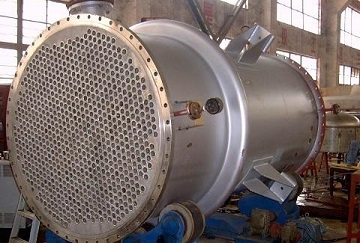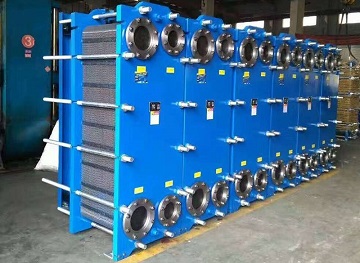Categories
- Pipe & Tube (18)
- Flange & Fitting (97)
- Fastener & Gasket (12)
- Valve & Pump (18)
- Base Material (11)
- Equipment (8)
- Application (30)
- Technical (110)
A heat exchanger is a heat-transfer device that is used for transfer of internal thermal energy between two or more fluids available at different temperatures. Whether the objective is to heat a liquid to a desired temperature or cool a product for final storage, the heat exchanger can accomplish both. It does not mix the two fluids, but rather transfer heat through contact with a surface of different temperature. Heat exchangers are used in the process, power, petroleum, transportation, air conditioning, refrigeration, cryogenic, heat recovery, alternate fuels, and other industries.

A shell and tube heat exchanger made of titanium Gr.2
A prevalent heat exchanger most people are familiar with is the common household water heater. Cold water flows around a heated element to warm the water. Other common examples of heat exchangers are automobile radiator, condensers, evaporators, air preheaters, and oil coolers, etc. Heat exchangers could be classified in many different ways.
A heat exchanger consists of heat-exchanging elements such as a core or matrix containing the heat-transfer surface, and fluid distribution elements such as headers or tanks, inlet and outlet nozzles or pipes, etc. Usually, there are no moving parts in the heat exchanger; however, there are exceptions, such as a rotary regenerator in which the matrix is driven to rotate at some design speed. The heat-transfer surface is in direct contact with fluids through which heat is transferred by conduction. The portion of the surface that separates the fluids is referred to as the primary or direct contact surface. To increase heat-transfer area, secondary surfaces known as fins may be attached to the primary surface.
Generally, industrial heat exchangers have been classified according to (1) construction, (2) transfer processes, (3) degrees of surface compactness, (4) flow arrangements, (5) pass arrangements, (6) phase of the process fluids, and (7) heat-transfer mechanisms. Among all of them, classification according to construction is the most prevalent classification in engineering practice.
| Base Type | Further Classification |
|---|---|
| Tubular heat exchangers | double pipe shell and tube coiled tube |
| Plate heat exchangers | gasketed spiral plate coil lamella |
| Extended suface heat exchangers | tube-fin plate-fin |
| Regenerators | fixed matrix rotary |
Heat exchangers can be classified into two basic types according to its heat-transfer process: indirect contact heat exchanger – the fluid streams remain separate, and the heat
transfer takes place continuously through a dividing impervious wall; direct contact type heat exchangers – there is a continuous flow of the heat from the hot fluid to the cold fluid through a separating wall. The indirect contact type can be further classified into direct transfer type, storage type and fluidized bed.

A typical plate heat exchanger.
Heat exchangers can be classified according to its surface compactness: compact type (if surface area density ≥ 700 m2/m3), or non-compact type (if surface area density < 700 m2/m3). Surface compactness is important when there are restrictions on the size and weight of heat exchangers. Heat exchangers can also be classified into 3 basic types according to flow arrangement: parallel-flow type, counter-flow type, and cross-flow type. A heat exchanger can also be distinguished according to pass arrangements: either single pass or multipass. Besides, based on the phase of fluids it is handling, the heat exchanger can be classified into gas-liquid type, liquid-liquid type and gas-gas type.
The classification of heat exchangers according to heat-transfer mechanisms cover: (1) single-phase convection on both sides; (2) single-phase convection on one side, two-phase convection on the other side; (3) two phase of convection on both sides; (4) radiative heat combined convection. Based on the phase change mechanisms, the heat exchangers are classified as condensers and evaporators.
Many factors shall be taken into account when selecting materials for heat exchangers: process fluids, working pressure, working temperature, ambient environments, vibration, cycle, lifespan, manufacture & fabrication, strength, cost, maintenance and inspection, etc. The primary purpose is to get reliable and sufficient performance of the heat exchanger while maintaining cost effective. A wide spectrum of metals are applicable for the construction of heat exchangers. It usually covers cast iron, carbon steels, low alloy steels, stainless steels, nickel alloys, titanium alloys, copper alloys, aluminum alloys, zirconium, and tantalum.
